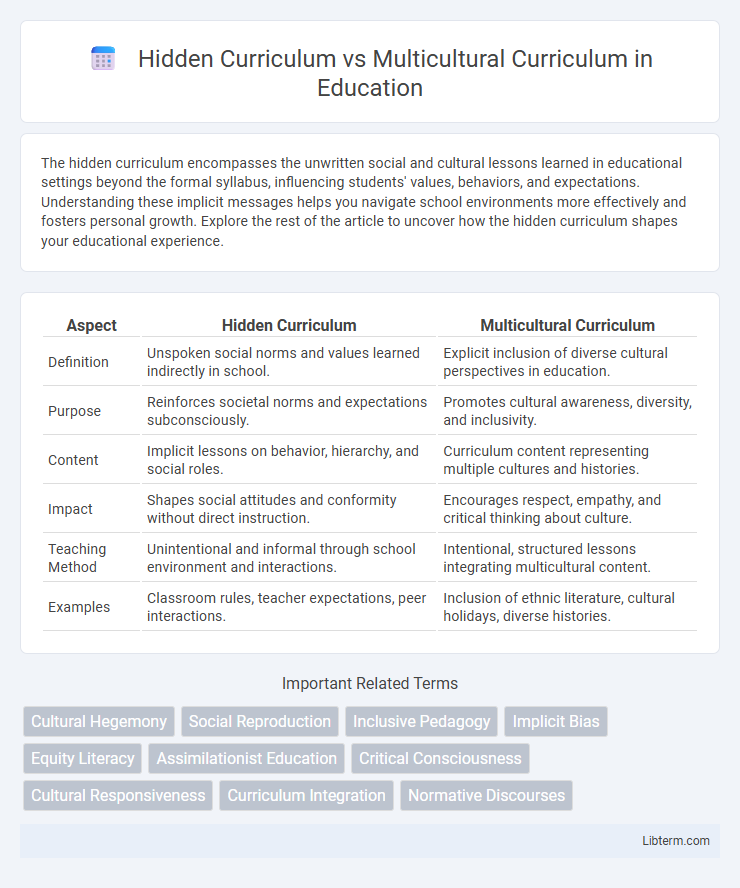The hidden curriculum encompasses the unwritten social and cultural lessons learned in educational settings beyond the formal syllabus, influencing students' values, behaviors, and expectations. Understanding these implicit messages helps you navigate school environments more effectively and fosters personal growth. Explore the rest of the article to uncover how the hidden curriculum shapes your educational experience.
Table of Comparison
| Aspect | Hidden Curriculum | Multicultural Curriculum |
|---|---|---|
| Definition | Unspoken social norms and values learned indirectly in school. | Explicit inclusion of diverse cultural perspectives in education. |
| Purpose | Reinforces societal norms and expectations subconsciously. | Promotes cultural awareness, diversity, and inclusivity. |
| Content | Implicit lessons on behavior, hierarchy, and social roles. | Curriculum content representing multiple cultures and histories. |
| Impact | Shapes social attitudes and conformity without direct instruction. | Encourages respect, empathy, and critical thinking about culture. |
| Teaching Method | Unintentional and informal through school environment and interactions. | Intentional, structured lessons integrating multicultural content. |
| Examples | Classroom rules, teacher expectations, peer interactions. | Inclusion of ethnic literature, cultural holidays, diverse histories. |
Understanding the Hidden Curriculum
The hidden curriculum refers to the implicit lessons, values, and norms conveyed through the educational environment, which influence students' attitudes and behaviors beyond the formal syllabus. Understanding the hidden curriculum is crucial for educators to recognize how societal biases and cultural assumptions can be perpetuated unconsciously within schools. Awareness of this hidden dimension allows for the development of more inclusive teaching strategies that complement a multicultural curriculum aimed at embracing diverse cultural perspectives.
Defining the Multicultural Curriculum
The multicultural curriculum integrates diverse cultural perspectives, histories, and contributions into the educational content, aiming to promote inclusivity and equity among students from various backgrounds. Unlike the hidden curriculum, which transmits implicit social norms and values unconsciously, the multicultural curriculum consciously challenges stereotypes and fosters critical thinking about cultural diversity. This approach enriches learning by validating students' identities and preparing them for a pluralistic society.
Key Differences Between Hidden and Multicultural Curricula
The hidden curriculum refers to the implicit lessons, values, and norms conveyed through school culture and social interactions, often unintentional and subtle, whereas the multicultural curriculum explicitly incorporates diverse cultural perspectives and content to promote inclusion and equity. Hidden curriculum influences students' socialization and identity formation implicitly, while multicultural curriculum aims to challenge and transform existing biases and stereotypes by consciously addressing diversity. Key differences include intentionality, content focus, and educational goals, with hidden curriculum being covert and culturally dominant, and multicultural curriculum being deliberate and inclusive.
Historical Context of Hidden Curriculum
The hidden curriculum refers to the implicit lessons, values, and norms conveyed in educational settings, often reflecting societal power structures and historical inequalities. Rooted in sociological and critical theory perspectives, its historical context traces back to the reproduction of class, race, and gender hierarchies through schooling, subtly enforcing conformity and social roles without explicit instruction. In contrast, the multicultural curriculum actively incorporates diverse cultural perspectives and histories to challenge dominant narratives and promote inclusivity.
Evolution of Multicultural Curriculum in Education
The multicultural curriculum has evolved significantly from merely addressing cultural differences to actively promoting inclusivity and equity within educational content, contrasting with the hidden curriculum that transmits implicit social norms and values. Educational reforms in the late 20th and early 21st centuries emphasized the integration of diverse perspectives, histories, and experiences into the curriculum to challenge systemic biases. This evolution highlights a shift toward culturally responsive teaching practices that validate and empower all students' identities and backgrounds.
Implicit Messages in Hidden Curriculum
The hidden curriculum transmits implicit messages about social norms, values, and expectations that reinforce existing power structures and cultural biases without explicit instruction. In contrast, a multicultural curriculum explicitly incorporates diverse perspectives and promotes inclusivity to challenge stereotypes and foster equity. Understanding the implicit socialization in hidden curricula is essential for educators aiming to create more culturally responsive and inclusive learning environments.
Promoting Diversity Through Multicultural Curriculum
Multicultural curriculum actively promotes diversity by integrating diverse cultural perspectives, histories, and experiences into the learning process, fostering inclusivity and respect among students. Unlike the hidden curriculum, which unintentionally perpetuates societal norms and biases, multicultural curriculum intentionally challenges stereotypes and encourages critical thinking about cultural identity and equity. This approach cultivates a culturally responsive educational environment that empowers all students to appreciate and engage with a broad spectrum of cultural narratives.
Impact on Student Identity and Socialization
The hidden curriculum influences student identity by transmitting implicit social norms, values, and expectations that often reinforce dominant cultural perspectives, subtly shaping students' behavior and self-concept within the school environment. In contrast, a multicultural curriculum actively integrates diverse cultural narratives and perspectives, promoting inclusivity and helping students develop a more complex and positive sense of identity that values diversity. Both curricula impact socialization, but the multicultural approach fosters critical thinking and empathy, enabling students to navigate and appreciate cultural differences more effectively.
Addressing Inequities in Both Curriculums
Hidden curriculum perpetuates inequities by reinforcing dominant cultural norms and biases often unconsciously transmitted through school routines and interactions. Multicultural curriculum actively addresses these inequities by incorporating diverse perspectives, experiences, and histories to foster inclusivity and equity in education. By critically examining power dynamics and representation, multicultural curricular approaches disrupt systemic biases embedded in traditional hidden curricula.
Strategies for Integrating Multicultural Perspectives
Implementing multicultural perspectives within the hidden curriculum involves intentionally embedding diverse cultural values, histories, and worldviews into everyday school practices and interactions. Strategies include revising school policies to reflect inclusivity, offering professional development for educators on cultural competence, and creating classroom environments that validate multiple identities and experiences. Emphasizing student-centered pedagogy and community engagement further promotes an equitable educational experience by challenging implicit biases and fostering cross-cultural understanding.
Hidden Curriculum Infographic

 libterm.com
libterm.com